 W
WAjmalan is a parent hydride used in the IUPAC nomenclature of natural products and also in CAS nomenclature. It is a 20-carbon alkaloid with six rings and seven chiral centres.
 W
WIn chemistry, a trigonal bipyramid formation is a molecular geometry with one atom at the center and 5 more atoms at the corners of a triangular bipyramid. This is one geometry for which the bond angles surrounding the central atom are not identical (see also pentagonal bipyramid), because there is no geometrical arrangement with five terminal atoms in equivalent positions. Examples of this molecular geometry are phosphorus pentafluoride (PF5), and phosphorus pentachloride (PCl5) in the gas phase.
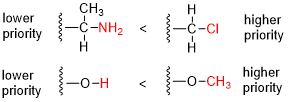 W
WThe Cahn–Ingold–Prelog (CIP) sequence rules, named for organic chemists Robert Sidney Cahn, Christopher Kelk Ingold, and Vladimir Prelog — alternatively termed the CIP priority rules, system, or conventions — are a standard process used in organic chemistry to completely and unequivocally name a stereoisomer of a molecule. The purpose of the CIP system is to assign an R or S descriptor to each stereocenter and an E or Z descriptor to each double bond so that the configuration of the entire molecule can be specified uniquely by including the descriptors in its systematic name. A molecule may contain any number of stereocenters and any number of double bonds, and each usually gives rise to two possible isomers. A molecule with an integer n describing the number of its stereogenic centers will usually have 2n stereoisomers, and 2n−1 diastereomers each having an associated pair of enantiomers. The CIP sequence rules contribute to the precise naming of every stereoisomer of every organic and organometallic molecule with all atoms of ligancy of fewer than 4.
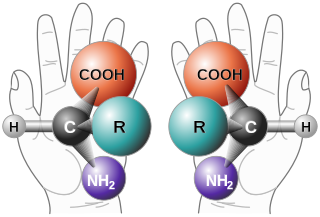 W
WIn chemistry, a molecule or ion is called chiral if it cannot be superposed on its mirror image by any combination of rotations, translations, and some conformational changes. This geometric property is called chirality. The terms are derived from Ancient Greek χείρ (cheir), meaning "hand"; which is the canonical example of an object with this property.
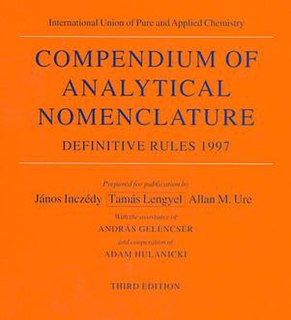 W
WThe Compendium of Analytical Nomenclature is an IUPAC nomenclature book published by the International Union of Pure and Applied Chemistry (IUPAC) containing internationally accepted definitions for terms in analytical chemistry. It has traditionally been published in an orange cover, hence its informal name, the Orange Book.
 W
WAn enyne is an organic compound consisting of a C-C-double bond (alkene) and C-C-triple bond (alkyne). It is called a conjugated enyne when the double and triple bonds are conjugated.
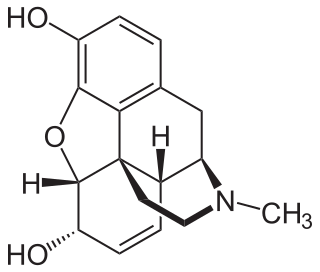 W
WIn chemistry and pharmacology, functional analogs are chemical compounds that have similar physical, chemical, biochemical, or pharmacological properties. Functional analogs are not necessarily structural analogs with a similar chemical structure. An example of pharmacological functional analogs are morphine, heroin and fentanyl, which have the same mechanism of action, but fentanyl is structurally quite different from the other two.
 W
WIn chemistry, the descriptor geminal refers to the relationship between two atoms or functional groups that are attached to the same atom. The word comes from Latin gemini meaning "twins". A geminal diol, for example, is a diol attached to the same carbon atom, as in methanediol. Also the shortened prefix gem may be applied to a chemical name to denote this relationship, as in a gem-dibromide for "geminal dibromide".
 W
WIn chemistry, homology is the appearance of homologues. A homologue is a compound belonging to a series of compounds differing from each other by a repeating unit, such as a methylene bridge −CH2−, a peptide residue, etc.
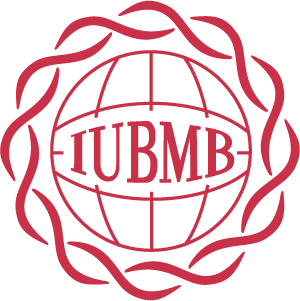 W
WThe International Union of Biochemistry and Molecular Biology (IUBMB) is an international non-governmental organisation concerned with biochemistry and molecular biology. Formed in 1955 as the International Union of Biochemistry (IUB), the union has presently 79 member countries and regions. The Union is devoted to promoting research and education in biochemistry and molecular biology throughout the world and gives particular attention to areas where the subject is still in its early development
 W
WThe International Union of Pure and Applied Chemistry is an international federation of National Adhering Organizations that represents chemists in individual countries. It is a member of the International Science Council (ISC). IUPAC is registered in Zürich, Switzerland, and the administrative office, known as the "IUPAC Secretariat", is in Research Triangle Park, North Carolina, United States. This administrative office is headed by IUPAC's executive director, currently Lynn Soby.
 W
WThe Karlsruhe Congress was an international meeting of chemists held in Karlsruhe, Germany from 3 to 5 September 1860. It was the first international conference of chemistry worldwide.
 W
WIn chemistry, noble metals are metallic elements that show outstanding resistance to chemical attack even at high temperatures. They are well known for their catalytic properties and associated capacity to facilitate or control the rates of chemical reactions. The short list of chemically noble metals comprises ruthenium (Ru), rhodium (Rh), palladium (Pd), osmium (Os), iridium (Ir), platinum (Pt), gold (Au), silver (Ag). In periodic table terms, an analogy can be made between the noble metals and the noble gases, which are mainly unreactive.
 W
WNomenclature of Organic Chemistry, commonly referred to by chemists as the Blue Book, is a collection of recommendations on organic chemical nomenclature published at irregular intervals by the International Union of Pure and Applied Chemistry (IUPAC). A full edition was published in 1979, an abridged and updated version of which was published in 1993 as A Guide to IUPAC Nomenclature of Organic Compounds. Both of these are now out-of-print in their paper versions, but are available free of charge in electronic versions. After the release of a draft version for public comment in 2004 and the publication of several revised sections in the journal Pure and Applied Chemistry, a fully revised version was published in print in 2013.
 W
WIn the IUPAC nomenclature of chemistry, a parent structure, parent compound, parent name, or simply parent is the denotation for a compound consisting of an unbranched chain of skeletal atoms, or consisting of an unsubstituted monocyclic or polycyclic ring system. Parent structures bearing one or more functional groups that are not specifically denoted by a suffix are called functional parents. Names of parent structures are used in IUPAC nomenclature as basis for systematic names.
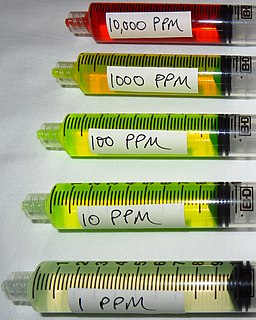 W
WIn science and engineering, the parts-per notation is a set of pseudo-units to describe small values of miscellaneous dimensionless quantities, e.g. mole fraction or mass fraction. Since these fractions are quantity-per-quantity measures, they are pure numbers with no associated units of measurement. Commonly used are parts-per-million, parts-per-billion, parts-per-trillion and parts-per-quadrillion. This notation is not part of the International System of Units (SI) system and its meaning is ambiguous.
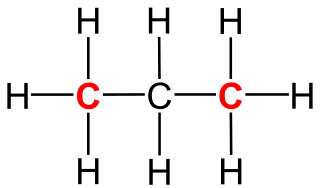 W
WA primary carbon is a carbon atom which is bound to only one other carbon atom. It is thus at the end of a carbon chain. In case of an alkane, three hydrogen atoms are bound to a primary carbon. A hydrogen atom could also be replaced by a hydroxy group, which would make the molecule a primary alcohol.
 W
WQuantities, Units and Symbols in Physical Chemistry, also known as the Green Book, is a compilation of terms and symbols widely used in the field of physical chemistry. It also includes a table of physical constants, tables listing the properties of elementary particles, chemical elements, and nuclides, and information about conversion factors that are commonly used in physical chemistry. The Green Book is published by the International Union of Pure and Applied Chemistry (IUPAC) and is based on published, citeable sources. Information in the Green Book is synthesized from recommendations made by IUPAC, the International Union of Pure and Applied Physics (IUPAP) and the International Organization for Standardization (ISO), including recommendations listed in the IUPAP Red Book Symbols, Units, Nomenclature and Fundamental Constants in Physics and in the ISO 31 standards.
 W
WA quaternary carbon is a carbon atom bound to four other carbon atoms. For this reason, quaternary carbon atoms are found only in hydrocarbons having at least five carbon atoms. Quaternary carbon atoms can occur in branched alkanes, but not in linear alkanes.
 W
WA secondary carbon is a carbon atom bound to two other carbon atoms. For this reason, secondary carbon atoms are found in all hydrocarbons having at least three carbon atoms. In unbranched alkanes, the inner carbon atoms are always secondary carbon atoms.
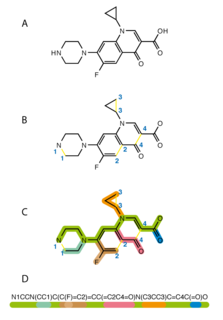 W
WThe simplified molecular-input line-entry system (SMILES) is a specification in the form of a line notation for describing the structure of chemical species using short ASCII strings. SMILES strings can be imported by most molecule editors for conversion back into two-dimensional drawings or three-dimensional models of the molecules.
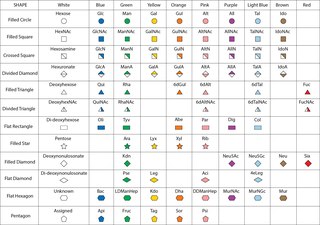 W
WThe Symbol Nomenclature For Glycans (SNFG) is a community-curated standard for the depiction of simple monosaccharides and complex carbohydrates (glycans) using various colored-coded, geometric shapes, along with defined text additions. It is hosted by the National Center for Biotechnology Information at the NCBI-Glycans Page. It is curated by an international groups of researchers in the field that are collectively called the SNFG Discussion Group. The overall goal of the SNFG is to:Facilitate communications and presentations of monosaccharides and glycans for researchers in the Glycosciences, and for scientists and students less familiar with the field. Ensure uniform usage of the nomenclature in the literature, thus helping to ensure scientific accuracy in journal and online publications. Continue to develop the SNFG and its applications to aid wider use by the scientific community.
 W
WA tertiary carbon atom is a carbon atom bound to three other carbon atoms. For this reason, tertiary carbon atoms are found only in hydrocarbons containing at least four carbon atoms. Tertiary carbon atoms can occur, for example, in branched alkanes, but not in linear alkanes.
 W
WIn chemistry, a trivial name is a nonsystematic name for a chemical substance. That is, the name is not recognized according to the rules of any formal system of chemical nomenclature such as IUPAC inorganic or IUPAC organic nomenclature. A trivial name is not a formal name and is usually a common name.
 W
WThe von Baeyer nomenclature is a system for describing polycyclic hydrocarbons. The system was originally developed in 1900 by Adolf von Baeyer for bicyclic systems and in 1913 expanded by Eduard Buchner and Wilhelm Weigand for tricyclic systems. The system has been adopted and extended by the IUPAC as part of its nomenclature for organic chemistry. The modern version has been extended to cover more cases of compounds including an arbitrary number of cycles, heterocyclic compounds and unsaturated compounds.